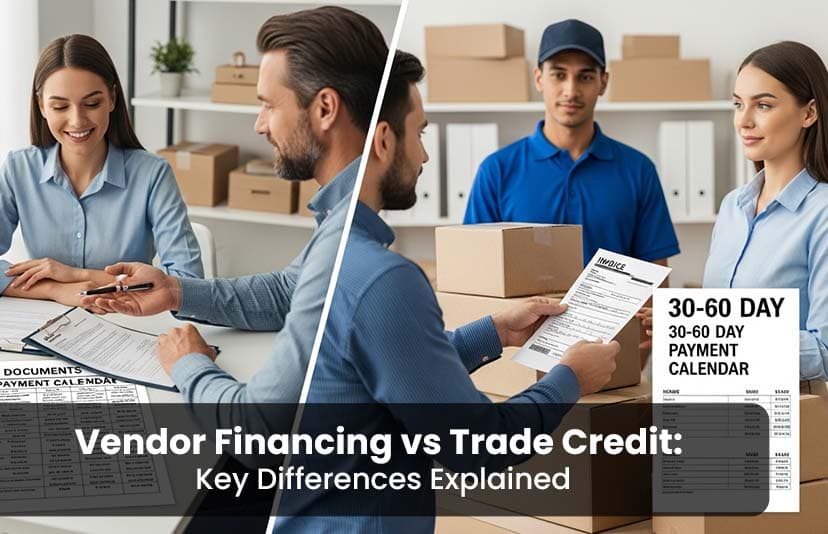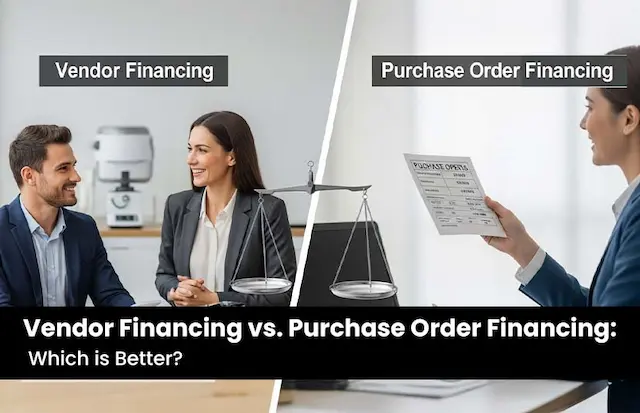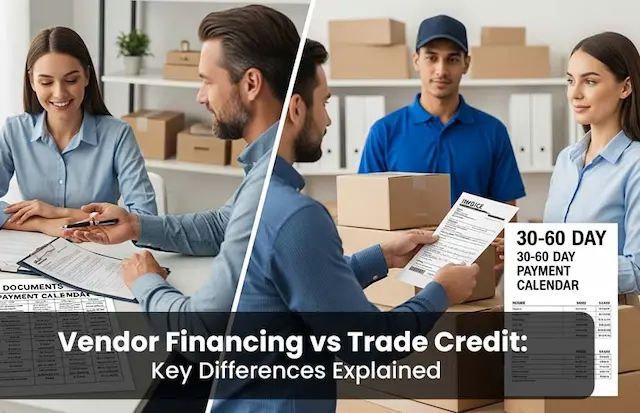In the modern, competitive global trade world, companies must rely on external funding to manage cash flow and finance expansion. Vendor financing and trade credit are two common methods employed. The two choices are short-term sources of liquidity and operational flexibility, but they work differently and apply to various business types. Knowing their differences is the key that allows MSMEs and exporters to maintain healthy working capital in addition to reducing financial risks.
Meaning of Vendor Financing
Vendor financing is a financing scheme in which a supplier (vendor) funds, either directly or indirectly, a buyer to purchase goods or services. Rather than go to a bank, the buyer gets funding from the vendor itself.
In certain instances, the vendor can provide payment terms that are deferred, or they can tie up with financial institutions and offer structured loans. Vendor financing may benefit exporters by allowing them to procure large orders without the concern of liquidity.
Examples – An exporter could pay an equipment supplier in instalments over two years as part of an arrangement that enables an equipment supplier to keep working capital and scale operations up.
Understanding the Meaning of Trade Credit
One of the oldest and most popular financing tools in business is trade credit. It enables a buyer to buy goods or services and make payment to the supplier after a stipulated credit period (usually 30, 60, or 90 days).
Trade credit is not typically formalised as a loan (as opposed to vendor financing). It is merely an interim lending of credit by the supplier. This credit is usually sought by exporters to fund the time lag between delivery and receipt of funds by foreign consumers.
Example – A clothing company can purchase raw cloth on credit terms of 60 days and process it by exporting it and paying the supplier after the foreign buyer pays them.
Key Differences Between Vendor Financing and Trade Credit
We can divide the key distinctions between vendor financing and trade credit into the following –
- Nature of Financing
- Vendor Financing – A form of financing that is based on a series of instalments or a loan.
- Trade Credit – It is an unofficial temporary contract that permits payments to be deferred in short periods.
- Repayment Terms
- Vendor Financing – This is generally long-term and paid in instalments.
- Trade Credit – This is a short-term credit that is generally due in 30-90 days.
- Documentation
- Vendor Financing – Involves agreements, credit checks and formal contracts.
- Trade Credit – Trade credit is often founded upon credit terms and mutual trust.
- Interest and Cost
- Vendor Financing – Can be charged with interest or otherwise.
- Trade Credit – Generally, no interest as long as the payment is made during the agreed time.
- Suitability
- Vendor Financing – This is best used when buying equipment such as machines, cars, or technology that are capital-intensive.
- Trade Credit – Suitable for operational requirements such as raw materials and supplies or temporary purchases.
Advantages of Vendor Financing
Vendor financing offers several advantages to companies that want to grow –
- Funds big purchases without a cash outflow.
- Helps exporters purchase technology and machinery that is essential in making them competitive.
- Low repayment plans as compared to the normal bank loans.
- Enhances vendor-buyer relations, which leads to a long-term partnership.
Advantages of Trade Credit
Trade credit is also useful, especially among MSMEs –
- Enhances liquidity in the short term through the payment deferral.
- Typically, no interest is charged, and it is therefore cost-effective.
- Simple to obtain with fewer formalities as compared to loans.
- Promotes long-term business with suppliers that are trustworthy.
Challenges of Vendor Financing
Vendor financing has its own challenges, despite all the advantages it-
- May accumulate long-term debts.
- It is subject to a higher interest rate than bank loans.
- Depends on the willingness and financial capability of the vendor.
- Threat of excessive reliance on a single financier.
Challenges of Trade Credit
Though trade credit is simple, it has limitations –
- The repayment window can be short and can be a burden on cash flow.
- Supplier relationships may be harmed by late payments.
- Purchase volumes may be limited by credit.
- It may not be accessible to new and risky buyers.
Vendor Financing vs Trade Credit: Which Is Better for MSMEs?
It all depends on the size, industry, and financial requirements of the business.
- Use Vendor Financing when investing in high-value assets or long-term projects whose payment can be made in steps.
- Select Trade Credit when you need rapid short-term funds to finance day-to-day business and working capital flows.
In many cases, MSMEs combine the two–vendor financing of capital purchases and trade credit of working supplies.
Making the Right Financing Choice
Vendor financing and trade credit are not the same thing. Vendor financing is appropriate for long-term investments, and trade credit is appropriate for short-term operational requirements. For MSMEs and exporters, the ability to select the correct option or even a combination of these two is the difference between limited cash flow and sustainable growth. The most appropriate approach would be to consider repayment ability, business scale, and supplier ties before making a decision. Finally, the correct financing choice can enable MSMEs to succeed in the competitive world market.
Delays, high costs, and unusual documentation are commonplace whenever MSMEs are negotiating financing alternatives. Credlix helps them at every point. Credlix provides exporters with its modern trade finance solutions to get access to factoring, purchase order financing, and working capital without having to wait long. By integrating digital solutions with adjustable funding, Credlix helps exporters to grow without losing good relations with suppliers.
Frequently Asked Questions
Q1: Is trade credit identical to vendor financing?
No, vendor financing is a formal loan provided through the vendor, and trade credit is an informal deferred payment.
Q2: Which is the cheaper alternative to MSMEs?
Trade credit is typically less expensive because it is interest-free, whereas vendor financing might encompass an interest fee.
Q3: Is vendor financing and trade credit both possible for MSMEs?
Most businesses have to strike a balance between long-term investments and short-term operational requirements.





